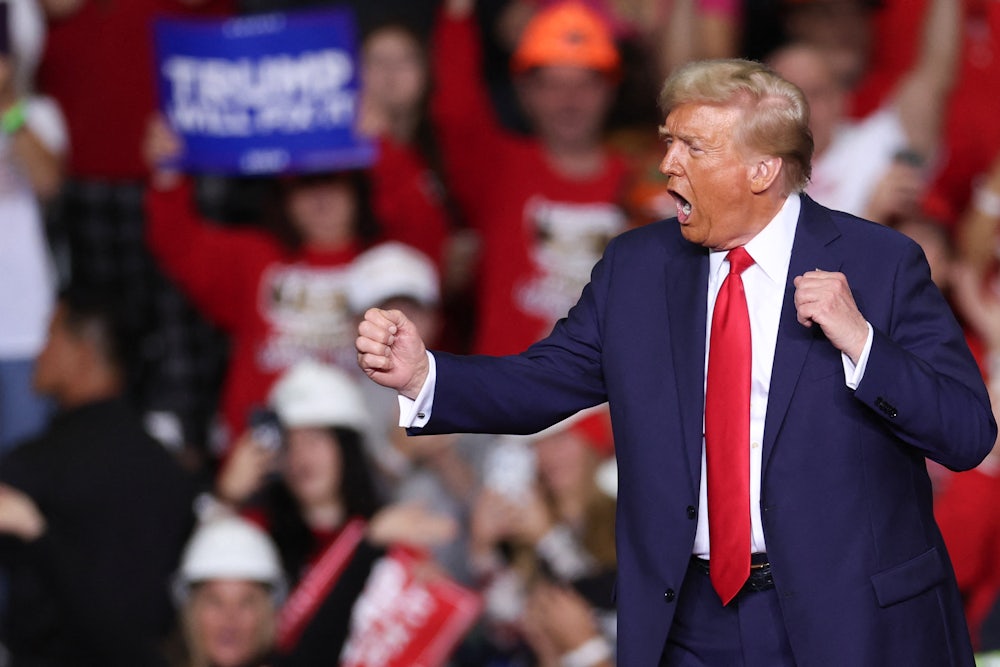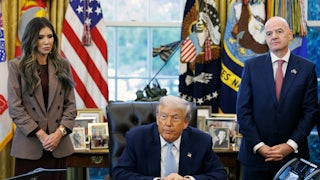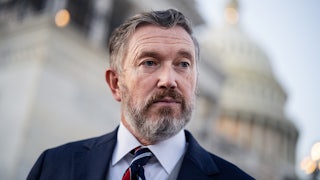How bad is it? This is very bad, and we are not nearly ready for what’s coming our way. In May and June 2024, I helped lead the Democracy Futures Project, a series of role-play simulation exercises hosted by the nonpartisan Brennan Center for Justice. The exercises were designed to better understand how a second Trump administration might play out—and which strategies might offer hope of countering the autocratic threats we knew were likely to come our way.
The DFP simulations involved almost 200 “players,” many of them with senior-level experience in past presidential administrations, including Trump’s first administration, along with former members of Congress, retired senior military officials, and civil society leaders from faith groups, nonprofits, universities, and grassroots organizations. The simulations began by assuming Trump had just been sworn in and proceeded from there.
Participants were assigned roles that drew on their prior experience (former senators played senators, retired four-star generals played four-star generals, and so on). Some were assigned to play members of the incoming Trump administration, others to represent those likely to be in opposition, from Democratic political leaders to civil rights groups. In the simulations, Trump announced his agenda and initial actions (we asked players to draw solely from actions Trump himself has indicated he supports), and players took turns responding to one another as the “games” unfolded. “War-gaming” exercises like these can help test assumptions, forcing participants to respond to dynamic, changing conditions in real time.
The results were sobering—many strategies relied upon by pro-democracy actors proved largely ineffective in countering moves by the Trump players. Here are a few of the lessons that emerged.
First, we should not imagine that litigation will be an effective tool for stopping egregious Trump administration actions. In recent decades, both political parties have cheerfully colluded in the steady expansion of executive power. The Insurrection Act and similar legislation grants the president extraordinary discretionary powers to declare emergencies. These would likely allow Trump to bypass the checks and balances that would normally constrain potentially norm-shattering executive actions, such as the possible deployment of active-duty military forces to the shutting down of protests in U.S. cities.
Litigation is slow and uncertain at the best of times, even when the law is less friendly to the executive. But now—thanks to the Supreme Court—we will have a president with substantial immunity from criminal prosecution. And even if courts rule against him, no one should feel confident about Trump’s willingness to abide by court orders.
This doesn’t mean litigation will be a complete waste of time. Private citizens, state and local government officials, and lower-level federal officials don’t have immunity from criminal prosecution, and the possibility of civil and criminal liability may deter some from engaging in acts of questionable legality. Litigation may at least slow or mitigate some Trumpian excesses. But our exercises suggested that the best means of pushing back against autocratic Trump administration actions lie in the realm of politics and culture.
Another lesson: In our exercises, large-scale protests on the streets and on college campuses consistently backfired. We live in a world rife with disinformation, and peaceful protests were quickly mischaracterized by Trump players as violent riots, even insurrection attempts. Throw in some agents provocateurs and AI deepfake videos, and peaceful protests led to “evidence” purporting to show out-of-control threats to public safety—which alienated the general public, triggered violent action by right-wing extremists, and was used by the Trump administration to justify draconian crackdowns on civil liberties, including mass arrests and the deployment of military personnel to “restore order.”
Granted, even totalitarian regimes can only arrest and imprison so many people. But our simulations suggest that defenders of democracy will need to be intentional about finding careful, creative ways to express dissent, given the risk that marches and rallies will be used as excuses for violent crackdowns. We can learn a lot from the experiences of human rights and pro-democracy movements in other countries; we Americans have been fortunate, thus far, to avoid the challenges of living under a lawless autocratic regime, but around the world, there are many with deep experience of doing so and of developing tactics that are most effective under such circumstances. For instance, sometimes work stoppages or symbolic gestures are as effective, and less risky, than street protest.
It may be helpful to think in terms of a “harm reduction” approach, at least at the federal level. We’re not likely to entirely stymie potentially autocratic Trump administration actions; “just say no to Trump” is unlikely to fare better than campaigns urging people to “just say no” to drugs.
Paradoxically, accepting the likely limits of what we can achieve may allow us to identify more effective ways of mitigating the damage a Trump presidency can inflict.
Our exercises made it clear that mitigation is feasible. We can, for instance, find ways to throw sand in the gears whenever possible. Patriotic civil servants and military personnel faced with ethically problematic directives can raise questions, insist on legal reviews, demand greater clarity, ask for more process. Members of Congress can ask questions and (if the Democrats manage to capture the House) hold hearings. Everyone concerned about autocratic overreach can, and should, seek allies of convenience, wherever they can be found; there will surely be enough backbiting and competition within Trump world—not to mention genuinely troubled moderates—for alliances to form on an issue-by-issue basis.
At the state and local level, governors, mayors, legislators, and other officials committed to rights and the rule of law can push back against federal overreach. They can ensure that state National Guard troops are used lawfully and responsibly, that state and local law enforcement protect peaceful protesters, and that state anti-militia and anti–swatting and harassment laws are strictly enforced. They can pass and enforce legislation designed to protect the people and rights targeted by the Trump administration. They can go to court to challenge inappropriate federal actions. (The left needs to learn to love federalism. If Texas can insist on its sovereign prerogatives, so can New York and California.)
We also urgently need a unified opposition leadership structure. In the five simulation exercises we conducted, pro-democracy actors consistently failed to coordinate effectively. The Trump administration had (and will have) a leader, a hierarchical structure, and all the powers of the executive branch, buttressed by a friendly Congress and sympathetic Supreme Court. In our exercises, the opposition was fragmented and discordant, unable to agree on tactics or messages.
To get through the next four years, we need to do better than that. We need Democratic leaders in Congress to connect with Republicans driven away by Trump, with retired political leaders from both parties who understand the threat Trump poses, and with civil society leaders from faith groups, unions, nonprofits, and other sectors. We need to develop the kind of tight, coordinated messaging and planning operation the GOP has long excelled at. It won’t come naturally to many. But to get through the next four years, we need to form disciplined opposition structures.
We can also do our best to protect the individuals and groups most likely to be targeted by a vindictive, lawless president. With the help of opposition leadership structures, we can establish and support protection networks that can quickly provide legal assistance, cybersecurity help, communications assistance, and even shelter or physical protection to those who find themselves under threat, whether the threat comes from politically motivated federal investigations or from violent private actors. Funders should ensure such protection networks are well financed, and ordinary people can help make sure their friends, colleagues, and neighbors know they will be there to help when needed.
This is as critical as anything else: Autocrats succeed by sowing fear and mistrust, making people opt to stay silent when it’s most critical that they speak up and step up. We need to be ready to protect one another. When people are standing up for human rights, the rule of law, and democratic institutions, we need to stand by them—even if we disagree passionately with them about everything else.
There is one issue now, and only one: keeping alive the vestiges of American democracy, with its commitment to meaningful checks and balances and to individual rights as well as majoritarian rule. American democracy has never been perfect, but it’s all we’ve got. When we have it, we can disagree peacefully and hope to remedy policy mistakes through discussion, legal action, and the ballot box. If we lose it, we’re done. So, whether you’re a fan of Bernie Sanders and the Squad or an admirer of Liz Cheney, we all need to stand together against Trump.
To have any hope of achieving the kind of disciplined unity that will be essential to countering Trump, we also need a rhetoric and politics of inclusion. The left needs to ease up on cancel culture, rigid purity tests, and petty identity politics. We can’t give up on one another, and we can’t waste time wallowing in self-pity, or make plans to emigrate to Canada. This is our country. Around the world, millions of brave people have pushed back against far more abusive and frightening leaders than Donald Trump. If they can stand up against truly horrific regimes in their own countries, Americans can handle Trump.






